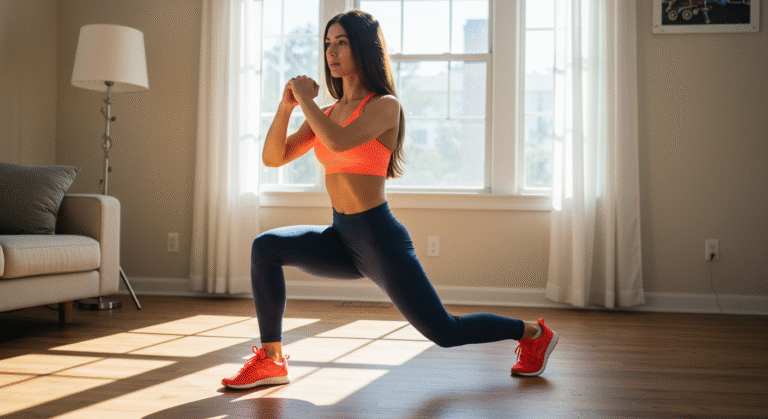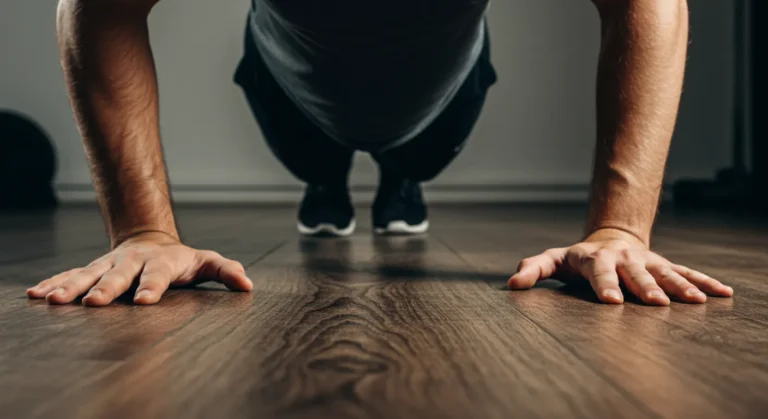Morning Workout Routine at Home: Energize Your Day in Just 15 Minutes

Let me guess. Your alarm goes off, and you hit snooze. Then hit it again. By the time you actually drag yourself out of bed, you’re already feeling behind, groggy, and wondering why mornings have to be so brutal.
Here’s the thing—you’re not lazy or broken. You’re just stuck in a cycle that millions of people know all too well.
But what if I told you that just 15 minutes of intentional movement could completely flip your mornings? That a simple morning workout routine could be the difference between stumbling through your day and actually feeling energized?
I’ve been there. Those mornings where you feel like you’re moving through thick fog, desperately reaching for that third cup of coffee, wondering when you started feeling so… blah.
The game-changer? Starting my day with movement. Not a grueling hour at the gym—just 15 focused minutes that reset my entire system.
Why Morning Movement is Like Magic for Your Body
Most people think exercise is just about burning calories or building muscle. But morning workouts do something way more powerful—they literally reset your internal clock.
Here’s what happens when you move your body first thing in the morning:
Your Circadian Rhythm Gets Back on Track Your body has this incredible internal timer that controls when you feel alert and when you feel sleepy. Morning exercise combined with natural light helps calibrate this system, making it easier to fall asleep at night and wake up refreshed.
Your Energy Hormones Kick Into Gear Movement triggers the release of cortisol (yes, the stress hormone—but in a good way) and dopamine, giving you natural energy that doesn’t crash like caffeine does.
Tonight’s Sleep Gets Better This is the part that blew my mind—when you exercise in the morning, your body produces better quality melatonin at night. It’s like your morning workout is programming your evening sleep.
The “Too Tired to Exercise” Cycle Breaks Ever notice how the less you move, the more tired you feel? Morning workouts interrupt this pattern before it can take hold of your day.
Think of it this way: if your body is a smartphone, morning exercise is like plugging it in overnight. You wake up at 100% instead of that frustrating 15% that barely gets you through the morning.
Your 15-Minute Energy Reset Routine
OK, let’s get practical. It’s not about having a suitability affects or correctly. It’s about awakening body and mind in the most effective way. I designed this routine for real people with real life – people who don’t have time for detailed workouts, but they will feel amazing in the skin.
- Total Time: 15 minutes
- Equipment: Just your body (and maybe a yoga mat if you have one)
- Frequency: 3-5 times per week (or whenever you need an energy boost)
Wake-Up Flow (3 minutes)
Start gentle. Your body is still transitioning from sleep mode.
Cat-Cow Stretches (30 seconds) Get on your hands and knees, arch and round your back slowly. This wakes up your spine after hours of lying flat.
Jumping Jacks (1 minute) Nothing fancy—just get your heart pumping and your blood flowing. If jumping feels like too much, do step-touches instead.
Hip Circles and Shoulder Rolls (90 seconds) Rotate your hips in both directions, roll your shoulders back and forward. Your joints will thank you for this gentle mobility work.
The Main Event (9 minutes)
This is where the magic happens. We’re going to do two rounds of this circuit with a short rest between.
Round 1 & 2 (4.5 minutes each):
Bodyweight Squats (45 seconds) Sit back like you’re sitting in a chair, stand up. Focus on form over speed. These wake up your largest muscle groups.
Push-ups (30 seconds) On your knees or toes—whatever feels challenging but doable. Even wall push-ups count. We’re after effort, not perfection.
Plank Hold (30 seconds) Strong core, straight line from head to heels. If 30 seconds is too much, start with 15 and build up.
Glute Bridges (45 seconds) Lie on your back, lift your hips. This counteracts all that sitting you’ll do later.
Mountain Climbers (30 seconds) Quick feet, strong arms. This gets your heart rate up and coordinates your whole body.
Rest (30 seconds) Breathe, shake it out, get ready for round two.
Cool Down and Center (3 minutes)
Don’t skip this part. It’s where you transition from “workout mode” to “ready for the day” mode.
Standing Forward Fold (30 seconds) Let gravity help stretch your back and hamstrings. This also gets blood flowing to your brain.
Spinal Twist (1 minute per side) Sitting or standing, gently rotate your torso. This feels incredible after movement.
Deep Breathing (1 minute) Inhale for 5, hold for 5, exhale for 5. This activates your parasympathetic nervous system, leaving you calm but alert.
Tools and Tricks That Make It Stick
The best morning workout routine is the one you’ll actually do consistently. Here are some game-changers that have helped me and thousands of others make this a lasting habit:
Essential Tools (But Not Required):
- A yoga mat makes floor exercises more comfortable
- Bluetooth speaker for energizing music
- A simple fitness tracker to see your progress over time
- Blackout curtains for better sleep (which makes morning workouts easier)
Natural Support:
- Magnesium before bed helps with deeper sleep and easier mornings
- A light therapy lamp if you wake up before sunrise
- Keep your workout clothes by your bed so there’s no decision-making required
Habit Stacking Secrets:
- Do your workout right after you use the bathroom (everyone does this)
- Reward yourself with your favorite coffee or tea afterward
- Track your workouts on a simple calendar—those X’s add up to motivation
The key is removing as much friction as possible. The easier you make it to start, the more likely you are to stick with it.
Beyond the Physical: What Really Changes
Here’s what nobody tells you about morning workouts—the physical changes are just the beginning.
After about a week of consistent morning movement, you’ll notice something interesting happens. You start making better decisions throughout the day. You choose the salad over the fries, take the stairs instead of the elevator, go to bed earlier because you want to feel good for tomorrow’s workout.
It’s like that 15 minutes creates a ripple effect of positive choices that compound throughout your day and week.
People often ask me about motivation, but here’s the truth: motivation is what gets you started, but routine is what keeps you going. After a few weeks, your morning workout stops being something you have to do and becomes something you get to do.
Making It Work for Your Real Life
Look, I know mornings are tough. Maybe you have kids who wake up at ungodly hours, or you work night shifts, or you travel constantly for work. The beauty of this routine is its flexibility.
Can’t do 15 minutes? Do 10. Can’t do it first thing? Try it during your lunch break. Can’t do jumping jacks because of downstairs neighbors? Do step-touches instead.
The point isn’t perfection—it’s progress. It’s choosing movement over stillness, even when (especially when) you don’t feel like it.
Some days you’ll nail the full routine and feel like a superhero. Other days you’ll manage five minutes of stretching and call it good. Both count. Both are moving you in the right direction.
Your New Morning Reality
Imagine this: your alarm goes off, and instead of dreading the day ahead, you feel curious about what you can accomplish. You move your body for 15 minutes, and by the time you’re sipping your coffee, you already feel accomplished.
Your energy is steady instead of crashing by 2 PM. You sleep better at night because your body actually feels tired in a good way. You start looking forward to mornings instead of surviving them.
This isn’t fantasy—it’s what happens when you give your body what it’s been asking for: consistent, intentional movement.
Your 15-minute morning workout routine isn’t just about exercise. It’s about reclaiming your mornings, your energy, and your relationship with your body.
Ready to find out what you’re capable of when you start your day right?
Disclaimer: The information provided is for educational purposes only, not a substitute for professional medical advice. Always consult a healthcare professional.







